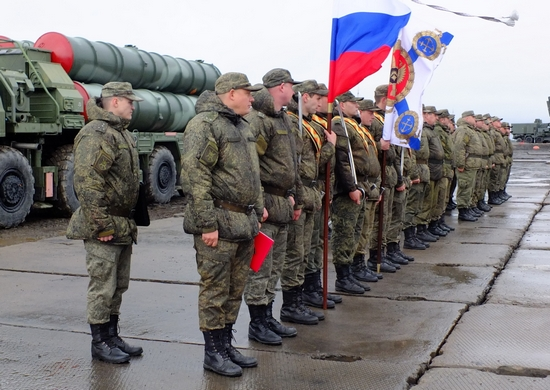RUSSIA MONITOR
Date: 25 September 2019
Missiles, Bases and Drills: Russia Flexes Military Muscles in the Arctic
Within the past two months, Russia has deployed new missiles systems on the territory of the Kola Peninsula. This comes as yet another stage of the country’s military build-up in the Arctic, a step that raises concern mainly in Norway. Russia keeps expanding its military infrastructure also east of the Kola Peninsula.

Russian army command has confirmed the S-400 system’s readiness for combat duty in Novaya Zemlya. The new S-400 anti-aircraft missile system replaces the older S-300. It has been fielded close to Rogachevo air base, on the southern island of Novaya Zemlya. From there, the S-400 system can hit targets over a large area of the eastern Barents Sea. These waters, west of Novaya Zemlya, are important patrol areas for Russia’s ballistic-equipped missile submarines. With a range of up to 380 to 400 kilometers, the S-400 missiles give a significant increase in protected airspace in the Russian Arctic. In addition to its wider range, the S-400’s another advantage compared with the older version is its ability to engaging targets within a few minutes. Its radar system is capable of tracking a multiple number of targets, both aircraft, and missiles. Fielded in Novaya Zemla, the S-400s are part of the 45th Air Force and Air Defense Army of the Northern Fleet, a military unit formed in December 2015, a year after Russia established its Arctic Joint Strategic Command with the Northern Fleet as the core of the new strategic formation. Anti-aircraft missile regiments are also put on full combat duty at the Arctic military camps at the archipelagos of Franz Josef Land, Severnaya Zemlya, and New Siberian Islands. Sometime before, a new battalion equipped with short-range missile systems Tor-M2DT was installed in the Kola Peninsula, in the military bases in the Pechenga valley along the borders to neighboring Norway and Finland. This is only 10 kilometers away from the Norwegian border. Less than 100 km away is located Vardø, the Norwegian town that is home to the Globus intelligence radar system. In late July, Russia’s Northern Fleet received the first battalion of the medium-range surface-to-air Pantsir-S to protect the air space over the town of Severomorsk that is home to the Fleet. Still in July, the Bal coastal missile system had been deployed in the Sredny Peninsula on the coast to the Barents Sea. It is capable of targeting both ships and land targets.
Support Us
If content prepared by Warsaw Institute team is useful for you, please support our actions. Donations from private persons are necessary for the continuation of our mission.
For several years, Russia has increased its firepower in the Arctic, and is also increasing the combat capabilities of the units stationed here. On September 18, over 2,000 Russian soldiers from 200. Motorized Infantry Brigade took part in large strategic-level drills scheduled to last a couple of days. Involved in the war games were also 400 pieces of military machinery and weaponry, including Grad rocket launchers, Gvozdika self-propelled howitzers, as well as drones and new tanks T-80BVM. The T-80BVM is an upgraded version of the T-80BV main battle tank, suited for operations in the Arctic. Early this year, it was announced that more than 20 new T-80BVMs would be delivered to the tank brigades throughout the Kola Peninsula. These were yet another military drills to take place in the area. In late August, another 800 men and 150 units of machinery launched similar military exercises. At the end of August, units from two military districts took part in maneuvers near the strategically important industrial plants of Norilsk Nickel in the Taymyr Peninsula. In Tiksi, a town on the coast of the Laptev Sea, the Russian army is soon expected to complete the construction of another Arctic military facility. In July, the base had its weaponry and machinery shipped. The new Tiksi base is reported to house 100 soldiers. Similar base complexes had earlier been built in the archipelagos of Franz Josef Land and the New Siberian Islands.
A military build-up in Russia’s Far North has long been one of the top priorities for the Kremlin, which goes in line with the growing strategic importance that the Russian authorities attach to the Arctic. Large military forces in this area are expected to stand out as an effective counterweight to the North Atlantic Alliance while serving a defensive role for energy and transport infrastructure currently being developed as part of the Northern Sea Route.
_________________________________
All texts published by the Warsaw Institute Foundation may be disseminated on the condition that their origin is credited. Images may not be used without permission.














